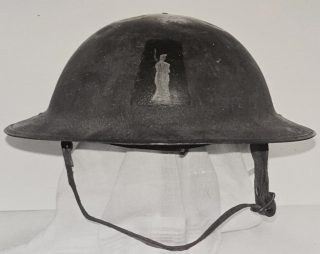Dear Mr. Felz, I really enjoy your weekly appraisals and in-depth comments. The enclosed pictures are of my uncle, Private First Class, Gustave H. Hansen of the 306th Field Artillery, 77th Division and some of his equipment. A native New Yorker of Wahington Heights in Manhattan. He was inducted into the AEF and went off to serve his country in Europe.
He kept a neatly painted, printed record of his campaigns on his gas mask carrier. In addition he kept two diaries of more than 200 pages each. His helmet with totally intact liner with a the Statue of Liberty logo are all in good shape.
I would think these WWI artifacts might be of interest to a number of groups or individuals. Value, of course, is another aspect of my inquiry. Uncle Gus was my mother’s brother and she, at the time, thought that the gas mask itself, included in the carrier, was dirty and dusty and she discarded it. However, thankfully she kept the carrier and helmet. Thank you for your help, A.J.Mergenthaler
What a great identified US Army World War I grouping. Your uncle was in a division that certainly saw their share of action during World War I. The Regiment was formed on August 5th, 1917, in the United States National Army. It was organized at Camp Upton, New York on August 29th, 1917. The 77th Division, including the 306th Field Artillery Unit, was a key part of the American Expeditionary Force (AEF) during the war. They trained with the British forces and learned their tactics, and their efforts contributed significantly to the Allied victory. Your uncle’s division was involved in several major battles during World War I, including the Oise-Aisne, Meuse-Argonne, Champagne and all the Lorraine offensives. This division was known as the “Statue of Liberty” Division, hence the Statue of Liberty on the front of your uncle’s helmet. Also, most importantly, it was particularly known for the “Lost Battalion,” a group of 154th Brigade soldiers who were cut off and surrounded by the Germans, during the Meuse-Argonne Offensive. The 306th Field Artillery suffered significant casualties. While the exact number of soldiers killed in action within the 306th Field Artillery is not known, the general understanding is that artillery units like this one experienced high casualty rates due to the nature of their assignment. Artillery was a major factor in the high casualty rates of World War I. Artillery units could inflict heavy losses with high-explosive shells, shrapnel, and poison gas. It is estimated that about half of all casualties in World War I were caused by artillery fire. Having had the privilege to carefully read your uncle’s diaries, it impressed upon me the carnage and suffering he witnessed first-hand. You are certainly correct in believing these artifacts might be of interest to military collectors. Perhaps, more than you can imagine. The fact you have his very thorough, and wonderfully written diaries adds a whole different dimension to this particular grouping. Now we have your uncle speaking to us, which in effect, makes the military items in this grouping “come alive” if you will. Including his US Army portrait, wearing his Doughboy uniform, his helmet, medals and gas mask carrier. Naturally this makes the value of this grouping soar in value. This is what is known as the “sum of all parts.” The current value for this fantastic World War I US Army, identified grouping is $4000 USD. Thank you for allowing me to read and study such personal, yet historically important diaries as those written by Private First Class, Gustave H. Hansen.
 0
0
You must be logged in to post a comment Login